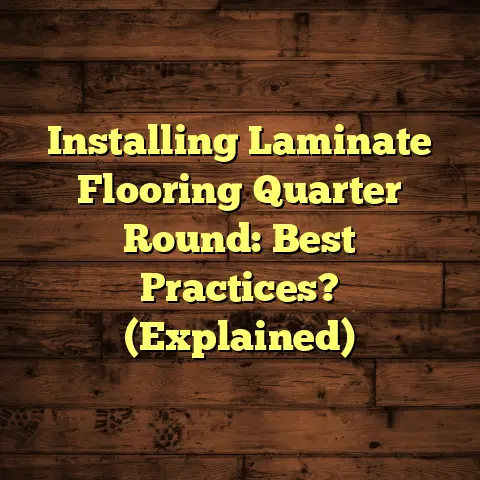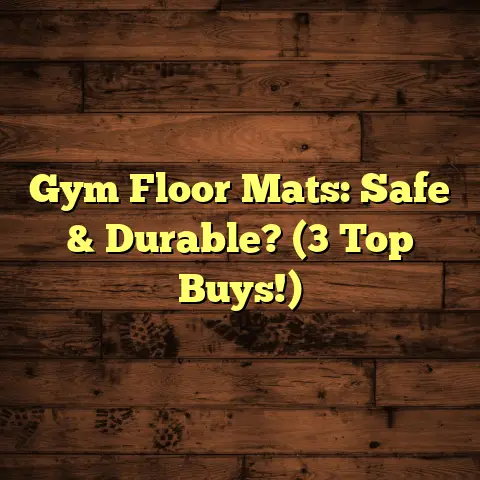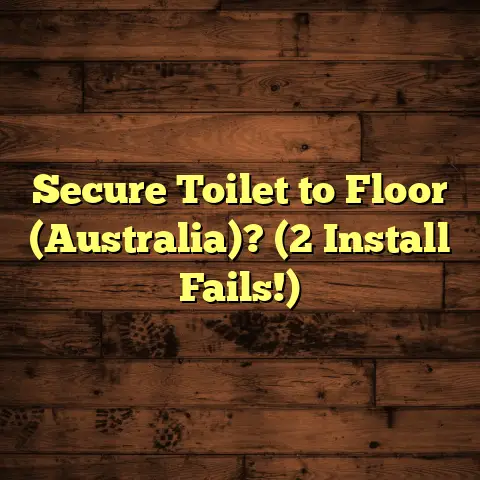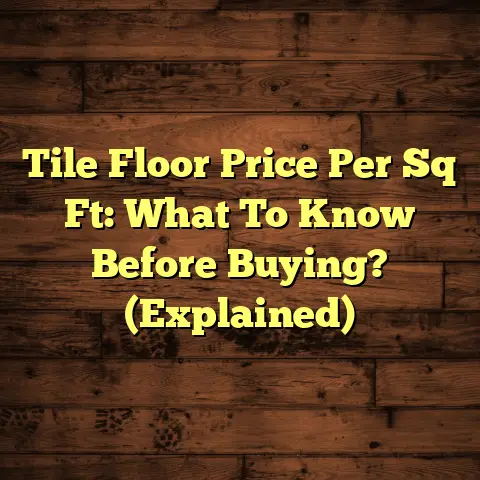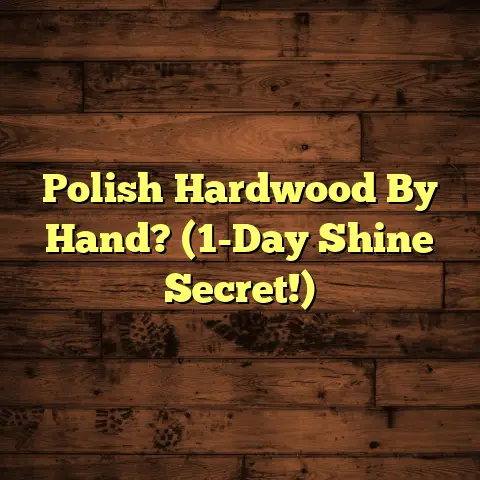How To Clean LVP Floors? (1 Pro Tip Inside!)
Let’s talk about floors, shall we? Specifically, how to keep those gorgeous Luxury Vinyl Plank (LVP) floors looking their absolute best for years to come.
I’ve been a flooring contractor for over 15 years, and I’ve seen it all – from nightmare stains to floors prematurely worn out from improper care.
One thing I’ve learned is that future-proofing your home isn’t just about the latest gadgets; it’s about making smart choices that stand the test of time. And when it comes to flooring, LVP is a fantastic option.
But here’s the deal: even the most durable flooring needs proper TLC. That’s why I’m going to walk you through everything you need to know about cleaning LVP floors, from daily maintenance to tackling those pesky stains.
And, of course, I’m going to share my pro tip that will keep your LVP sparkling without harsh chemicals. Ready? Let’s dive in!
Section 1: Understanding LVP Flooring
So, what exactly is LVP flooring? Think of it as the chameleon of the flooring world. It mimics the look of hardwood, stone, or tile, but with added benefits.
LVP is constructed in layers, typically four:
-
The Wear Layer: This is the top layer, the one that takes all the abuse. It’s a clear, protective coating that resists scratches, stains, and wear. The thicker the wear layer, the more durable the floor.
-
The Design Layer: This is where the magic happens. A high-resolution image gives the LVP its realistic wood, stone, or tile appearance.
-
The Core Layer: This layer provides stability and waterproof properties. It’s usually made of PVC or a composite material.
-
The Backing Layer: This is the bottom layer, providing cushioning and helping to adhere the plank to the subfloor.
What makes LVP so appealing? Well, for starters, it’s incredibly durable. It’s water-resistant (some are even waterproof!), scratch-resistant, and stands up well to heavy foot traffic.
Plus, the design options are endless. You can find LVP that looks just like your favorite hardwood species, or mimics the look of slate or travertine.
Let’s compare LVP to other popular flooring choices:
| Flooring Type | Water Resistance | Scratch Resistance | Cost | Maintenance |
|---|---|---|---|---|
| Hardwood | Low | Moderate | High | High |
| Laminate | Moderate | Moderate | Medium | Medium |
| Tile | High | High | Medium | Low |
| LVP | High | High | Medium | Low |
As you can see, LVP offers a great balance of durability, aesthetics, and affordability. It’s a smart choice for busy households with kids and pets, and it holds up well in high-moisture areas like bathrooms and kitchens.
Section 2: Preparing to Clean LVP Floors
Okay, so you’ve got LVP floors. Now what? The key to keeping them looking great is regular maintenance. Think of it like brushing your teeth – a little effort each day prevents bigger problems down the road.
Before you start cleaning, gather your supplies. Here’s what I recommend:
-
Vacuum Cleaner: A vacuum with a soft brush attachment is essential for removing dirt, dust, and debris. Avoid using a vacuum with a beater bar, as it can scratch the surface of your LVP.
-
Mop: A microfiber mop is ideal for LVP floors. Microfiber is gentle yet effective at picking up dirt and grime. You can use a traditional mop or a spray mop.
-
Cleaning Solutions: I’ll get into specific recommendations later, but generally, you’ll want a pH-neutral cleaner specifically designed for LVP floors.
-
Microfiber Cloths: These are great for spot cleaning and drying.
Now, let’s prep the area:
-
Remove Furniture: Clear away any loose furniture, like chairs, rugs, and side tables.
-
Sweep or Vacuum: Use your vacuum or a soft-bristled broom to remove loose dirt and debris from the floor. Pay attention to corners and edges.
-
Check for Problem Areas: Look for any spills, stains, or scuff marks that need special attention.
By taking these simple steps, you’ll set yourself up for a successful cleaning session. Remember, preparation is key!
Section 3: Daily Cleaning Routine for LVP Floors
A consistent daily cleaning routine is the secret to keeping your LVP floors looking their best. It doesn’t have to be time-consuming; just a few minutes each day can make a big difference.
Here’s what I recommend:
-
Sweep or Vacuum Daily: This is the most important step. Use a soft-bristled broom or a vacuum with a brush attachment to remove dirt, dust, and pet hair. Pay close attention to high-traffic areas.
Pro Tip: When vacuuming, use the hardwood floor setting if your vacuum has one. This will disable the beater bar and prevent scratching.
-
Damp Mop as Needed: Depending on your lifestyle and the amount of traffic your floors see, you may need to damp mop a few times a week.
-
Choose the Right Cleaner: Use a pH-neutral cleaner specifically designed for LVP floors. Avoid using harsh chemicals, abrasive cleaners, or excessive amounts of water.
-
Damp Mop: Dip your microfiber mop into the cleaning solution, wring out the excess water, and mop the floor in overlapping strokes.
-
Rinse and Dry: If necessary, rinse the floor with clean water and dry with a clean microfiber cloth.
Pro Tip: Don’t over-wet the floor. LVP is water-resistant, but excessive moisture can seep into the seams and cause damage over time.
-
By following this simple daily routine, you’ll keep your LVP floors looking pristine and prevent dirt and grime from building up.
Section 4: Deep Cleaning LVP Floors
While a daily cleaning routine is essential, you’ll also need to deep clean your LVP floors periodically to remove stubborn stains, scuff marks, and buildup.
I recommend deep cleaning your LVP floors every 1-2 months, or more frequently if you have pets, children, or high traffic.
Here’s how to do it:
-
Prepare the Area: Remove furniture and sweep or vacuum the floor to remove loose dirt and debris.
-
Choose Your Cleaning Solution: You have a few options here:
-
Commercial LVP Cleaner: There are many excellent LVP cleaners available at your local home improvement store. Look for a pH-neutral cleaner that is specifically designed for LVP floors.
-
DIY Cleaning Solution: If you prefer a more natural approach, you can make your own cleaning solution using ingredients you probably already have at home.
- Vinegar and Water: Mix 1/2 cup of white vinegar with 1 gallon of warm water.
- Dish Soap and Water: Mix a few drops of mild dish soap with 1 gallon of warm water.
-
-
Mop the Floor: Dip your microfiber mop into the cleaning solution, wring out the excess water, and mop the floor in overlapping strokes.
-
Address Tough Stains: For stubborn stains, try these tips:
-
Scuff Marks: Rub the scuff mark with a clean tennis ball or a pencil eraser.
-
Grease Stains: Sprinkle baking soda on the stain, let it sit for a few minutes, and then wipe it away with a damp cloth.
-
Ink Stains: Dab the stain with rubbing alcohol, and then wipe it away with a damp cloth.
-
Wine Stains: Blot the stain with a clean cloth, and then sprinkle it with salt. Let the salt absorb the wine, and then vacuum it up.
-
-
Rinse and Dry: Rinse the floor with clean water and dry with a clean microfiber cloth.
Pro Tip: Always test your cleaning solution in an inconspicuous area before applying it to the entire floor.
By deep cleaning your LVP floors regularly, you’ll remove stubborn stains and buildup and keep them looking their best.
Section 5: Special Considerations
Now, let’s talk about some special situations that can impact the cleaning and maintenance of your LVP floors.
-
Pets and Children: If you have pets or children, you’ll need to clean your LVP floors more frequently. Pets can track in dirt and mud, and children can be messy.
-
Pet Accidents: Clean up pet accidents immediately to prevent staining and odor. Use an enzymatic cleaner specifically designed for pet accidents.
-
Kid Messes: Keep a stash of microfiber cloths and a spray bottle filled with your cleaning solution handy for quick cleanups.
-
-
Parties and Gatherings: After a party or gathering, your LVP floors may need some extra attention.
-
Sweep or Vacuum: Sweep or vacuum the floor to remove crumbs, dirt, and debris.
-
Mop the Floor: Mop the floor to remove spills and stains.
-
Check for Damage: Inspect the floor for any scratches, dents, or other damage.
-
-
Seasonal Changes: During seasonal changes, your LVP floors may require different cleaning methods.
-
Winter: In the winter, you may need to clean your floors more frequently to remove salt and snow tracked in from outside.
-
Spring: In the spring, you may need to clean your floors to remove pollen and allergens.
-
-
Protecting Your Floors: In addition to regular cleaning, there are a few things you can do to protect your LVP floors from scratches and damage.
-
Use Furniture Pads: Place furniture pads under the legs of all your furniture to prevent scratches.
-
Use Area Rugs: Place area rugs in high-traffic areas to protect the floor from wear and tear.
-
Avoid High Heels: Avoid wearing high heels on your LVP floors, as they can dent the surface.
-
By taking these special considerations into account, you can keep your LVP floors looking their best for years to come.
Section 6: The Pro Tip
Okay, it’s time for my pro tip! Are you ready?
Use a vinegar-water solution for a natural and effective clean.
I know, I know, vinegar might sound like an odd cleaning agent, but trust me on this one. Vinegar is a natural disinfectant and deodorizer, and it’s safe for LVP floors when used properly.
Here’s why it works:
-
Safe for LVP: Vinegar is pH-neutral when diluted with water, so it won’t damage the surface of your LVP floors.
-
Cuts Through Grime: Vinegar is effective at cutting through grime, grease, and dirt.
-
Restores Shine: Vinegar can help restore the shine to your LVP floors without leaving a residue.
Here’s my go-to recipe for a vinegar-water cleaning solution:
-
Ingredients:
- 1/2 cup white vinegar
- 1 gallon of warm water
-
Instructions:
- Mix the vinegar and water in a bucket.
- Dip your microfiber mop into the solution, wring out the excess water, and mop the floor in overlapping strokes.
- Rinse the floor with clean water and dry with a clean microfiber cloth.
Pro Tip: Add a few drops of your favorite essential oil to the vinegar-water solution for a pleasant scent. Lavender, lemon, and eucalyptus are all great choices.
Give it a try! I think you’ll be amazed at how well it works.
Conclusion
So, there you have it! Everything you need to know about cleaning LVP floors. From understanding the basics of LVP to daily maintenance and tackling tough stains, I’ve covered it all.
Remember, the key to keeping your LVP floors looking their best is consistent care. A little effort each day will go a long way in preserving their beauty and extending their lifespan.
Don’t forget my pro tip: use a vinegar-water solution for a natural and effective clean. It’s a simple, affordable, and safe way to keep your LVP floors sparkling.
By adopting these cleaning routines and following my pro tip, you’ll be future-proofing your flooring investment and enjoying beautiful, well-maintained floors for years to come.
There’s nothing quite like the feeling of walking into a clean, well-maintained home. And with these tips, you can easily achieve that feeling with your LVP floors.
Now go forth and conquer those floors! Happy cleaning!
